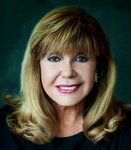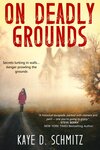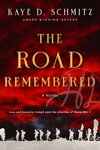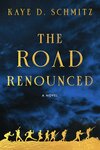




Kaye D. Schmitz is an award-winning author of four published novels, the first being “The Consort Conspiracy, A Covington Family Mystery,” published in 2017. To that, she has added three more and has become a popular writer among book clubs.
Tell me about the books you wrote after “The Consort Conspiracy.”
Since “The Consort Conspiracy,” I’ve had three more books. The second one turned out to be “On Deadly Grounds.” The first two were murder mysteries.
The third one, “The Road Remembered,” is a story of how love and humanity triumphed amid the atrocities of World War II. We all know the stories of World War II; in this book, you will meet the people who lived them.
It’s told in what is called “time slip fashion,” which means I have a current-day part of the story, and then one that was 70 years old.
I understand that book was based in part on your father’s real-life experiences, but also the lives of other real people.
I decided I would tell my dad’s story and what happened to him during World War II.
My dad had been a part of the 89th Infantry Division. I thought: I have so many questions, but he’s gone.
So, I did research on the internet about the 89th Infantry Division to see if I could find any other soldiers who were still alive. And I found one in Austin, Texas — but then I found his obituary.
But in the obituary, they mentioned a surviving twin brother. I looked him up and found a name and phone number.
I thought: OK, it’s Tuesday afternoon; I have enough nerve to call this gentleman out of the blue.
So, I called him and got a message saying, “Please leave Erwin Davis a message.” I started to talk and I started to cry because he’d been part of the same thing. Anyway, he picked up, and then I really lost it.
Finally, he got his daughter on the phone, and I tried to explain to her: I’m not just some crank calling out of the blue. And finally, when I got myself under control, I said to her, “It almost feels like I spoke to my dad from the grave.”
What happened then?
We had a wonderful conversation. We communicated several times. I was able to actually fly out to Austin, and I spent a day talking to him. Well, it was one of the greatest experiences of my life.
So, I got his story and his twin brother’s story. He and his brother at 18 were bazooka gunners in the war. Anyway, Mr. Davis gave me permission to use his story and his name and his brother’s story and his name and incorporate that into the story that I was trying to tell.
So, I incorporated my dad’s story. I incorporated the twins’ story. Then, people started sending me names of World War II veterans. I ended up interviewing about eight of them.
I included all of that in the third book, which I called “The Road Remembered.”
It was about the 70th anniversary of the war. My main character, Sam, who had a lot of the experiences my dad had, is telling all of these stories to his daughter, who accompanies him to the 70th anniversary [observance] of the war with his soldier buddies.
That’s how I got the story. That’s how I did the modern-day part of the story and the one that was 70 years old.
Listening to author Kristin Hannah’s “The Nightingale” had a profound effect on the direction of your novel. Tell me about that.
As soon as I listened to that story, I thought … I just needed more.
So, I did more research, and I found the name of a Polish social worker, Irina Semblar. Germany had overtaken Poland and incorporated that into its territory — so, even though she was a Polish social worker, she saved 2,500 Jewish people, most of which were children.
I did a character based on her for my story. I actually made her a German woman who happened to be married to a Nazi officer. … Here is this German woman who loved her husband very much but didn’t buy into the Nazi dogma. Under his nose and behind his back, she helped save — and in my story, it was 1,200 — almost entirely Jewish children from being exterminated.
I’m telling both stories [Sam’s and the German wife’s] simultaneously. And then they come together at the end.
Your dad’s experiences actually did cross paths with the Davis twins and their participation in the war. Tell me about that.
I was writing the chapter about the American soldiers discovering the Ohrdruf concentration camp. My dad had actually talked about that.
So, this Mr. Davis from Texas had also given me a copy of the actual diary he kept, his journal, as they went from battleground to battleground. … And come to find out, it was the Davis twins who actually fired the bazooka shot at the gates of Ohrdruf to try to open them.
So, I was able to incorporate that real-live fact in my story.
At the end, I went chapter by chapter and told what was true and what I had either made up or enhanced. Everybody seemed to really like that, because it’s historically accurate, mostly.
The thing that broke my heart was Mr. Davis was able to read the book, because he was one of my early readers. He and his daughter both read it. But by the time it came out he was in hospice in really bad shape.
I had one preview copy, so I overnighted that to his daughter. She put it in his hands the night before he died. He was such a sweet, wonderful gentleman and it still breaks my heart.
You also had another significant source, a local man.
I was also able to interview a fighter pilot who lived in Ponte Vedra. His name was Mike Spencer. And he supported Patton’s troops from the air while my dad’s troop was slugging through the mud on the ground. I just thought that was interesting.
Tell me about the book that followed that one.
In the latest book, book number four, called “The Road Renounced,” I explore a lot more of Sam’s family and early life. That takes place primarily during World War I, so it’s actually a prequel to book number three.
“The Road Renounced” is a World War I tale of one soldier’s triumphs and tragedies as told by the woman who loves him. The story is Sam’s father’s story and Sam’s mother Maude’s story.
Sam shows up in the book but as a child. In my character’s case, Sam’s father Buzz has fathered seven children, but the night his seventh child was born he disappeared, and the family never saw him again.
Buzz was a baseball player who was drafted for the war, and he went kicking and screaming. He didn’t want to leave playing baseball. He was afraid something would happen to him. …
The fourth book also has another character. And the characters come together toward the end.
This one is a Belgian nurse named Marthe Peeters. And she’s probably the favorite character I have ever, ever written. I just love that woman. She is one of the protagonists.
I have an American part of the story with the parents of my soldier from the previous book. And then, on the other side of the war, I have this Belgian nurse.
I based her character on a real person called Marthe McKenna, who actually wrote a book not long after World War I was over. The book even has a forward by Winston Churchill. The book was called “I Was a Spy.”
That woman was just awesome. So, I used a lot of her experiences, and then brought in more of my own. Of course, eventually, I had her meet my other characters.
Buzz is the one who meets Marthe, actually in France. And they spend time together there.
You bring together two separate stories in the course of your novel.
That’s my favorite way to tell a story. I tell parallel stories, and then the storylines get closer and closer until they actually cross. And characters from both stories spend time together.
Is “The Road Renounced” available now?
That one came out in December/January. It’s going very, very well.
My early readers said, “Actually, I think this is your best book ever.” I guess part of it is I just learned more things to do and avoid the things I’m not supposed to do.
How long does it take you to write a book?
That depends. I worked on my first book for 20 years before it was actually published. “The Road Remembered” probably took about two years. “The Road Renounced” was under a year, because I already knew the whole story.
How can people get a copy of your books?
I always invite people to come to my website: www.kayedschmitzauthor.com. I have a store on my website, so I can personalize the books to them or to someone they choose to order for. Then, I send them to wherever they want me to send them.
The other thing I’ve done recently is bundle the four books. To buy each book separately, it would be $85. But I am bundling all four for $70.
However, if people don’t care to have them personalized, they’re available from Amazon and Barnes & Noble. Unfortunately, my books are not appearing on bookshelves yet, but you can order them from anywhere.
When you’re trying to develop ideas, do you have any kind of process you rely on?
The way I see it is: anything can be a storyline.
My husband and I will be watching television, and I’ll say, “What if this happened?” And it will go from there. The ideas normally come in quicker than I can even write them down.
For my first book, I got the idea from an old cemetery, reading an epitaph on an above-the-ground crypt from the 1700s.
For the second book, I had visited this huge mansion just outside Los Angeles where a murder took place six months after the family had moved in. I took that story and moved it to North Carolina.
For the third book, I had my dad’s map [detailing his battlefield travels in the war], and that gave me the idea for the story.
The fourth book just kind of came as the result of things I felt I had left unfinished in the third book.
Have you ever found that a project isn’t working?
As a matter of fact, I have a storyline that I love, and a main character, Judith, who gets murdered in the first chapter. And I’ve got seven chapters of that book written and haven’t been able to finish it. I got stuck. My editor wanted me to do something else, and so I put it aside, thinking: OK, I’ll get back to it. And just never have.
In my third book, I included the first chapter of the fourth book to try to get people to want to read it. But as I got ready to really write the fourth book, I realized I gave away too much. So, all the information from that chapter is somewhere in the book but just stretched out, because I didn’t want you to be able to guess too early what was happening.
I addressed that by putting a reader’s note into the fourth book, saying, “OK, I know a lot of you read this first chapter, but here’s why I changed it.”
And I let them know that the story takes on a mind of its own sometimes.
In the first book, I had the main character’s grandmother. And the best I could do, she never rang true with me. So I just eliminated her. She just happened to have died before the story started. We still referred to her from time to time, but she wasn’t actually in the book.
Who are some of your favorite authors?
I adore Kristin Hannah.
I also really love Steve Berry. Not only is he a great author, he’s also one of my friends. He had written a number of books, and then he moved to King & Bear within the World Golf Village community. I had gone to his website, and even though it said, “Don’t do this,” I sent him my story and said, “Will you read it?” And he did!
As a matter of fact, he invited me to come to his house, and he spent three hours with me at his dining room table showing me how I could make the writing stronger, use fewer words and other things that I’ve now incorporated into everything I do.
I also love Karen White, who writes paranormal and ghost stories. Those really appeal to me.
I really like Dorothea Benton Frank. She wrote a series of what she called “low-country” stories that took place in South Carolina close to the ocean.
Would you say these authors had an influence on your writing?
Absolutely. Dorothea had an influence on my ability to write some of my characters almost girlfriend-style. And Steve, of course, had an influence with helping me build suspense and keep suspense going.
And then, with Kristin Hannah, as I said, from her, I got the idea that I needed to have a parallel character or parallel story that I would eventually bring together at the end.
So, yes. And I just like Karen White stories.
What have you learned about the writing life by living it?
Before I was published, I figured: Once I get published, I’m going to make so much money that I can quit my day job. Well, unless you get picked up by a company that really puts a lot of marketing dollars behind you, there will be good royalties that come in, but probably not enough to quit your day job right away.
But it’s still a wonderful thing to do.
The reason to write, I have also learned, is not to make money but to write because you can’t not write. Because you have to tell the stories.
One of the other things is: You want to use all the beautiful words you know. Then, you want to impress people by looking up more beautiful words. Come to find out: That doesn’t work.
When I look at the first things that I wrote — and what other people have written and asked me to read — what I find is people use way too many modifiers. I was the same way.
“The beautiful, bright sunlight pierced the amazing blue sky.” You know, it’s like, uh, gag me.
Tell the story to the point. That’s probably the main thing that I learned.
Another thing: sometimes, the characters will just flat-out take over the story, and there’s not a whole lot you can do about it.
Also, don’t let your research show.
I had done great research about how a textile mill works, because that figured into a death in one of my books. I finished the chapter, took it to my husband — who is my first reader — and when he came back to my office, I said, “Well, what did you think?”
He said, “I think your research is showing.”
So, I took out four pages’ worth of stuff about how a textile mill works and condensed it to two paragraphs, because that’s all I needed.
For beginning writers — and I was one of them — it’s really hard, because you’re so excited about what you found out and you want to include everything.
It’s also very hard for most beginning authors to just scrap stuff you’ve written because it doesn’t work. But you have to.
The other thing I will say is don’t ever, ever throw words away. On a computer, it’s easy to just hold on to them forever. Eventually, you may go back and be able to use an idea from something that didn’t work in something else.
Do you have signings or appearances coming up?
Yes, I do. I have one on Saturday, June 24, at the World Golf Village Renaissance St. Augustine Resort. That is with the Jacksonville Business Connections, the Women's Relax & Reset Event.
That one’s from 3 to 6. In fact, that’s a great event for anybody to go to, whether you’re in the market for a book or whatever. But I will definitely have my books there, and I’ll have the book bundles there. What better way to rest and relax than with a good book?
And then there’s another one. That one is Aug. 19, and that one will be at UNF. It’s called the Jacksonville Makers Market. And that will be from 11 to 3 at the UNF Adam W. Herbert University Center.
Do you work with book clubs?
I worked with a PR specialist who had my book entered into several contests and were chosen by book clubs. Four book clubs chose my book, and I was able to send them copies. Two of them were in New York. One was in Pennsylvania. …
So, the club is able to read the book, and then I get on the computer with them [via Zoom], and we can talk about the book. They can ask me questions, and so forth.
Book clubs are my absolute favorite things.
How would a book club get in touch with you?
Through my website. There’s a place to send me a message, and I will get right back to them.
I’ve done a number of book clubs here in the area. In fact, for “The Road Remembered,” I think I did half a dozen or more book clubs here in the area.
I love being there with people that I know have read my words and appreciate them. The other thing that happens as a result of that is I’ve made such great friends.
One of the clubs actually invited me to join their book club, and one of the other ones went to see the movie “Book Club” and invited me to go with them. And I said, “Yes, I’d love to.” We had a wonderful time.
To read brief synopses of the novels of Kaye D. Schmitz, click here.